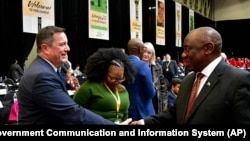After weeks of political deal-making, South African President Cyril Ramaphosa has announced the Cabinet of his new government of national unity. Ministers from different parties will now have to put political differences aside to run the country successfully.
South Africa’s new ministers are a diverse group — from a former armed robber to a white Afrikaner nationalist.
After the long-governing African National Congress, or ANC, lost its majority in May elections, Ramaphosa opted to form an inclusive government with 10 opposition parties that don’t necessarily see eye to eye.
Ramaphosa had to divvy up Cabinet positions to keep everyone happy, with the result a somewhat bloated government of 32 ministers and 43 deputy ministers.
“The establishment of the government of national unity in its current form is unprecedented in the history of our democracy. We have had to consider how to form the new government in a manner that advances the national interest, that gives due consideration to the outcome of the election and that makes use of the respective capabilities within each of the parties,” he said.
The ANC took 20 of the 32 Cabinet posts, while the Democratic Alliance, or DA, which came second in the elections, won six. Smaller parties took the remainder.
The DA has long been a thorn in the ANC’s side, and its leader, John Steenhuisen, who was made agriculture minister, noted that the road ahead would be “difficult.”
Steenhuisen, however, pledged to try and make the new government work.
“It is now up to all of us — including the voters who created this multi-party government — to ensure that it delivers on its promise,” he said.
Experts say the ANC — which liberated South Africa from apartheid 30 years ago — only won 40% of the vote in polls in May due to a flailing economy, high unemployment, electricity and water shortages and corruption scandals.
The business-friendly DA, which captured 22% of the vote, will now head some key economic portfolios including agriculture and public works and infrastructure as well as getting deputy minister positions in the finance and trade ministries.
David Everatt, a politics professor at the University of the Witwatersrand, said the government of national unity was expected to try to give roles to all members.
“However, the Cabinet has ballooned to a remarkable 75 people, ministers and deputy ministers… the most ironic part of that is that the Democratic Alliance, which is a fairly conservative liberal party, has for many years lambasted the ruling African National Congress for having these very large Cabinets, giving jobs to pals, et cetera. They’re now sitting in exactly those seats,” he said.
The uMkhonto weSizwe party, led by corruption-accused former President Jacob Zuma, finished third in the voting, and the radical Marxist Economic Freedom Fighters came in fourth.
Both parties have refused to join the government of national unity, and object to the white-led DA’s participation. They will now be on the opposition benches.
Other smaller parties that did join and were given portfolios include the anti-immigrant, populist Patriotic Alliance and the right-wing white nationalist Freedom Front Plus.
The Patriotic Alliance’s leader, Gayton McKenzie, an ex-gangster who was sentenced to 17 years in prison for robbery, is now minister for sports, arts and culture. Pieter Groenewald of the FF Plus has been made minister of correctional services.








